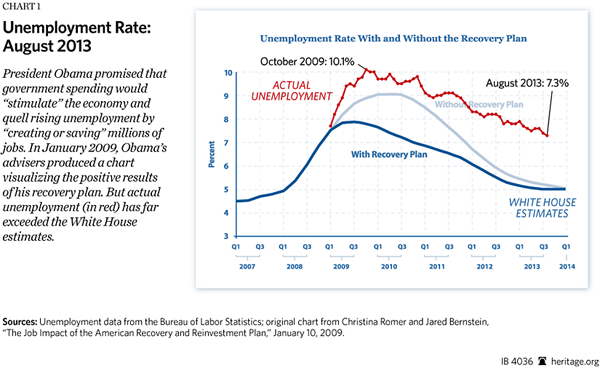The labor market remains one of the weakest aspects of the broadly mediocre economic recovery. Although the headline unemployment rate has gradually fallen to 7.3 percent, job creation has merely kept up with population growth, not regaining the ground it lost in the Great Recession.
The unemployment rate has fallen because fewer Americans are looking for work. The labor force participation rate has now hit a 35-year low. Economic factors—not the aging of the baby boomers—explains the vast majority of this drop.
August Employment Report
The payroll survey reports that employers added 169,000 net new jobs in August—approximately the same rate of growth as over the past year. Employment grew the most in the retail trade (+44,000), health care (+33,000), leisure and hospitality (+27,000), and professional and business services (+23,000) sectors. Despite sequestration, government employment expanded by 17,000 jobs, with large increases in local government employment and no loss in federal jobs.
Employment fell in the information (–18,000), nondurable goods manufacturing (–8,000), and finance (–5,000) sectors. Other indicators showed modest increases in labor demand: The average work week increased by 0.1 hours to 34.5 hours, and average hourly earnings increased at a 2.5 percent annual rate.
However, this preliminary data may overstate the actual strength of the labor market. Revisions to previous data subtracted 74,000 jobs from estimated growth in June and July. The Bureau of Labor Statistics now reports that employers only added 104,000 positions in July, down from an initial estimate of 162,000.
The household survey finds a much less robust labor market. The headline unemployment rate dipped a statistically insignificant 0.1 percentage points to 7.3 percent. However, that decrease occurred solely because 516,000 Americans left the labor force. Labor force participation fell to 63.2 percent—its lowest level in 35 years. The total number of Americans with jobs (–155,000) and unemployed (–198,000) both fell despite the adult population expanding (+203,000).[1] Since people not looking for work do not count as unemployed, the unemployment rate fell. The employment-to-population ratio also fell 0.1 points to 58.6 percent.
Labor Force Participation
The growing number of Americans who report that they are not looking for work continues a very troubling trend. Even as the economy recovers, the fall in labor force participation that began in 2008 has continued unabated.
Some analysts have attributed the recent sharp fall in labor force participation to demographics instead of the economy. Older Americans are much more likely to retire and drop out of the labor force than younger workers. The aging and retirement of the baby-boom generation will naturally decrease labor force participation irrespective of economic conditions. However, such demographic factors can explain only one-quarter of the drop in labor force participation between 2007 and 2012.[2] Economic factors are to blame for the rest of the drop in employment.
Among the nearly 6 million Americans who (on net) left the labor force since 2007, there are nearly equal increases in the number of those retiring, going on disability, and in school, with a small number having left for other reasons. However, these increases are not distributed equally across the population.
Only 34 percent of those without high school diplomas are employed, while over 11 percent now report collecting disability benefits. Disability is designed for those with debilitating health problems. When those who are healthy enough to work fraudulently enter disability, they hurt the truly disabled and diminish their future prospects, because it is very difficult to exit disability status.[3] The fact that the disability rolls increase sharply during recessions, at a time when health care is improving rapidly and fewer Americans work in physically demanding jobs, suggests statistically that many of the new enrollees can work but cannot find jobs. Unlike unemployment insurance, which is designed to return people to the labor force, disability insurance will keep most of its new enrollees out of the labor force even when the economy recovers.
The implementation of Obamacare will also depress labor force participation. It introduces large new effective tax rates on work for families between the poverty line and median income: The more they earn, the less they receive in insurance exchange subsidies. This amounts to a roughly 10 percentage point tax increase for half the U.S. population.[4] Marginal effective tax rates were already high for many of these families,[5] and Obamacare will make working even less attractive.
The prospects for the 2 million who have stayed in school rather than join the labor force are much brighter. There are fewer high school dropouts and a million more college students.[6] Although there is some cause for concern about ever-expanding student debt, college remains an excellent investment for those who attend and study in fields valued by employers.[7]
Reversing the Decline
Economic policy in the U.S. should focus on returning the labor market—and the rest of the economy—to a strong, long-term growth path. Arguments for more Keynesian stimulus are based on the idea that government spending might smooth over a brief downturn. But “brief” ended a long time ago, and the employment indicators are still discouraging. When the economy is growing but labor markets are lagging far behind, lawmakers should look for solutions to that specific problem, not Band-Aids that boost gross domestic product for a few quarters.
Policies that can encourage greater employment include keeping the minimum wage low, more stringent requirements for disability insurance, easing occupational licensure, and lower labor taxes. Unemployment insurance should continue to ease back to more normal levels. Obamacare should be repealed and the welfare system as a whole should be reformed so that marginal effective tax rates on low-income families never approach 100 percent.
Ultimately, the government has a limited capacity to induce economic growth. That comes from the hard work, thrift, and ingenuity of everyone in the economy. But the government can remove or reform destructive policies, and it should.
—James Sherk is Senior Policy Analyst in Labor Economics and Salim Furth, PhD, is Senior Policy Analyst in Macroeconomics in the Center for Data Analysis at The Heritage Foundation.



